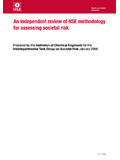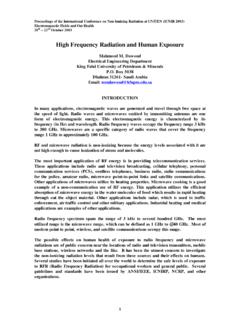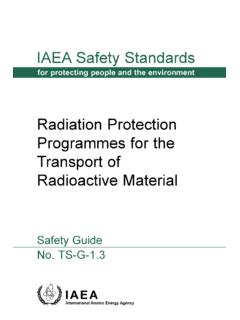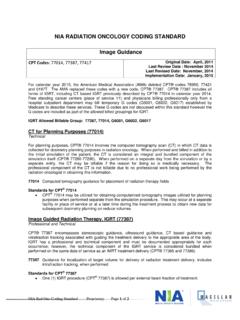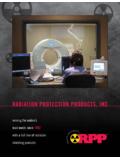Transcription of Radiation protection supervisors
1 HSE information sheet Radiation protection supervisors Ionising Radiation protection Series No 6. Introduction Training for RPS. This HSE information sheet is aimed at Radiation The Radiation employer has a specific duty to provide employers, Radiation protection advisers (RPA), Radiation appropriate training for all employees working with protection supervisors (RPS), safety representatives and ionising Radiation (see regulation 14). For RPSs, the workers. It gives advice on the level of knowledge and purpose of such training is to ensure that they know management responsibility that would make a person enough about Radiation protection principles and suitable for appointment as an RPS under regulation procedures, the requirements of the Regulations and the 17(4) of the Ionising Radiations Regulations 1999 arrangements in local rules to enable them to supervise (IRR99)1 and builds on the guidance in the Approved the work safely and maintain the precautions that will Code of Practice2 (L121, paragraphs 289-295).
2 Restrict exposure. Role of RPS The length of the training, including refresher training, depends upon the experience of the RPS and the The RPS has a crucial role to play in helping to ensure complexity of the work being undertaken. At one compliance with the arrangements made by the Radiation extreme, as little as a few hours of specific training, eg from the RPA, may be sufficient. In other circumstances employer under IRR99 and, in particular, supervising the (if the nature of the employer's business is complex and arrangements set out in local rules. The legal the RPS has not already completed any form of Radiation responsibility for supervision, however, remains with the protection training) a longer course of perhaps a few Radiation employer.
3 Days' duration may be necessary. However, it may be economical to provide a thorough training course for a The RPS will generally be an employee of the Radiation group of RPSs, only parts of which would be of direct employer, although this is not a legal requirement. They relevance to the individuals. Some situations may will usually be in a line management position, closely require a wider background knowledge of Radiation involved with the work being done, to allow them to protection than the minimum suggested here. It is for the exercise sufficient supervisory authority. In some Radiation employer to decide, in the light also of advice situations, for example where a contractor is undertaking from their RPA, how much training is needed in work on the site of another employer, it may be individual cases and how to provide it.
4 Appropriate to appoint one of that site employer's employees as the RPS. Such an appointment might be Minimum level of competence for RPS. appropriate where the site employer is a Radiation employer and the contractor rarely undertakes work with Employers should satisfy themselves that the people ionising Radiation and may need to be confirmed by they appoint to act as RPSs: suitable contractual arrangements. have received appropriate information and It may not always be necessary for an RPS to be instruction as required under regulation 14;. present all the time. In deciding how many RPSs are know and understand the requirements of the required, the Radiation employer will need to take Regulations and Approved Code of Practice account of the range and complexity of the work that is (L121), local rules and contingency plans relevant subject to local rules and the number of different to the work with ionising Radiation .
5 Locations to be covered (see L121, paragraph 293). possess sufficient authority to allow them to supervise all the Radiation protection aspects of the In some large establishments the RPS may not be the work in areas subject to local rules;. immediate line manager or supervisor overseeing the know what to do in an emergency; and work with ionising Radiation . In these cases a system know where to seek more information or advice. should operate, which may involve more than one person, to ensure that adequate supervision is Training modules maintained. In all cases the Radiation employer should provide sufficient resources and managerial support to The modules that follow comprise a basic level of allow the RPS to operate effectively.
6 It is good practice, knowledge or expertise (core of competence) for an though not a legal requirement, to confirm the RPS. The degree of detail that each module should appointment in writing and to provide sufficient provide will depend on the range of tasks to be information about the individual's role. Radiation supervised and the individual's previous level of relevant employers may find it helpful to involve their RPAs in the knowledge. There is no significance to the order of the presentation of the modules. selection, appointment and training of RPSs. Core of competence for RPS modules and how those principles are carried through in the particular work situation.
7 NB: For completeness, the core of competence suggested here may include information that all Radiation 6 In-house knowledge, as appropriate: workers should receive. the Radiation employer's safety policy and organisation;. 1 The nature of ionising Radiation and its interaction the specific functions the RPS would be expected with tissue - confined to those types of ionising Radiation to undertake;. which may be encountered, but including: relevant dose limits;. operational levels set by the employer for the the nature of any harmful effects; particular workplace;. the principle of restricting exposure to ionising content of the local rules established by the Radiation so far as reasonably practicable; and Radiation employer.
8 The concepts of internal and external Radiation contingency plans; and exposure. where help and advice can be obtained. 2 The quantities used for: 7 Practical procedures to be followed in the event of an accident, incident, emergency or other unwanted measuring ionising Radiation , including the units of occurrence, including procedures for reporting adverse measurement; incidents. activity of radioactive substances; and contamination; Relevant reading as appropriate to the circumstances. 1 Ionising Radiations Regulations 1999 SI. NB A detailed understanding of all dose quantities may 1999/3232 Stationery Office 2000 ISBN 0 11 085614 7.
9 Not be needed, provided there is an understanding of what is meant by the general term dose of ionising 2 Work with ionising Radiation . Ionising Radiations Radiation '. Regulations 1999. Approved Code of Practice and guidance L121 HSE Books ISBN 0 7176 1746 7. 3 Relevant measurement techniques (ie those that will be met in the course of normal work), for example: While every effort has been made to ensure the accuracy of the references listed in this publication, their film badge; future availability cannot be guaranteed. thermo-luminescent dosemeter (TLD);. electronic dosemeter; Further information other personal dosemeter.
10 Bioassay; HSE priced and free publications are available by mail air sampling; and order from HSE Books, PO Box 1999, Sudbury, Suffolk workplace portable monitors for Radiation and CO10 2WA. Tel: 01787 881165 Fax: 01787 313995. contamination. Website: 4 Basic legal requirements: HSE priced publications are also available from good booksellers. the Ionising Radiations Regulations 1999 (IRR99). and Approved Code of Practice (L121); The Stationery Office (formerly HMSO) publications are local rules, their purpose and how to use them to available from The Publications Centre, PO Box 276, secure compliance with the Regulations; London SW8 5DT.









